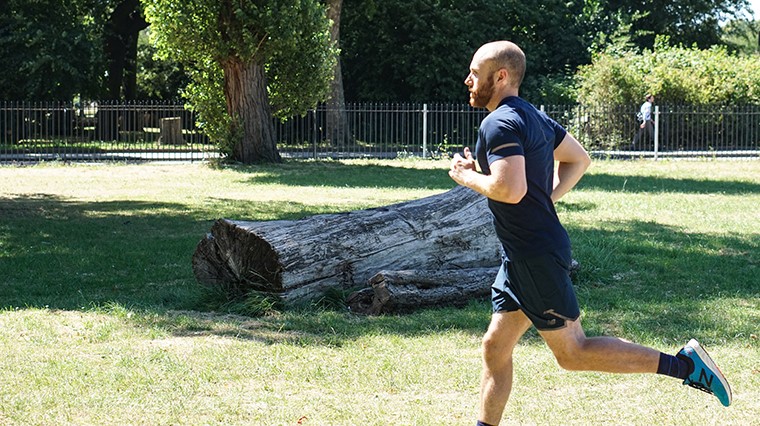A Runner's Guide: Should You Push Through The Pain?

Push through the pain. You’ve heard it before, but is this really the right thing to do?
Pain or the anticipation of pain can spark anxiety or put your training off track. On the other hand, many road warriors choose to ignore pain, unaware that it may grow into full-blown injury and turn into a major setback.
In this article we’ll teach you how to differentiate normal running discomfort from injury-associated pain and show you a snapshot of common running ailments to guide your choices as you put your best foot forward.
Discomfort vs pain

We all experience ‘niggles’ when pounding on the pavement; those pesky sores, tinges and aches that distract our focus. Although we all have a different pain tolerance, there are ways to deal with running discomfort. Discomfort tends to be mild, dull and short-lived, reducing as you stop or slow down the pace. It usually takes form as a more generalised soreness or fatigue of the muscles.
Pain on the other hand is often sharp, constant or targeted at a specific joint. It may occur suddenly and unexpectedly and be accompanied by swelling and inflammation that doesn’t alleviate in a short period of time.
Pain weirdly enough is your friend. It's a self-preservation mechanism that exists for a reason, signifying when you should stop or seek medical attention to prevent risk of developing or further exasperating injury.
Do a body scan

Doing a mental body scan while running allows you stay in tune with your movement and to make any tweaks necessary to improve your running form and identify pain.
Rather than push through the pain, a better mantra may be to:
Assess the discomfort/pain - Whether it’s a sign of injury that needs to be addressed, or whether it’s non-injury related.
Accept the discomfort and carry on - If it’s minor and tolerable, it’s simply another challenge that will allow you to consequently build mental strength OR;
Stop - If it’s a sharp and severe pain, you may require medical attention.
Not as catchy as push through the pain we know, but the above mindset is more likely to keep you on the running track rather than stuck on the sidelines with injury.
Common running discomfort: Adapt and carry on

Side stitches
Usually associated with the cramping of the diaphragm. To reduce your risk, avoid eating a large meal up to two hours pre-run. Take a walking break until the discomfort eases, and practice proper breathing technique.
Burning sensation in your muscles
Often considered ‘good pain’, this burning sensation is associated with lactic acid build-up, but alleviates at rest. Invest in compression tights or compression sleeves to minimise the effects and increase oxygen supply to hard-working muscles.
Burning sensation in your lungs
A common complaint of beginner runners, often associated with the increased load on your underworked lungs.
With regular exercise, your lungs will adapt and become stronger and more efficient, and you’ll feel less out of breath with increased effort, especially if you put proper breathing technique into action.
Normally, this discomfort fades when you stop or slow the pace, but do consult a medical professional if you have exercise-induced asthma, chest tightness or recurringly experience lung pain post-workout.
Sore, tender and dull sensation of the feet or knees
Common for beginner runner’s as your body adapts to impact stresses. Gradually increase distance and intensity to reduce the effects. Also, consider your footwear – does it provide adequate cushioning and stability? Is it appropriate for your foot type?
DOMS (Delayed Onset Muscle Soreness)
A temporary aching or stiffness of the body caused by micro-tears in your muscles. It’s often experienced 24 – 72 hours post-workout, particularly after long or intense exercises, or exercises your body is not familiar with.
It's nothing to get your laces in a knot about, but don’t neglect rest and recovery to allow your worn-out muscles to repair.
Fatigue or ‘lead’ legs
The heavy, exhausted feeling in your muscles is a natural part of training, particularly as you increase mileage and intensity. Stay hydrated before, during and post-run and be cautious of fatigue that you do not normally experience at your current training level – iron deficiency may be the culprit. Also, be wary of overtraining as a risk factor.
Common running pain: Not to be ignored

Runner’s knee
What is it? Also called patellofemoral pain syndrome (PFPS), runner's knee is often caused by repetitive stress to the knee joint or when the back of the kneecap becomes irritated, unable to slide smoothly through your femur (thigh bone) groove due to improper running form.
What does it feel like? A deep, sharp pain may be felt around the kneecap and typically intensifies when running on an incline or decline.
Management and Prevention: Seek medical treatment. Avoid boosting mileage too quickly, ensure you warm-up and stretch adequately, practice proper running form and wear shock-absorbing running shoes to reduce your risk in future.
Stress fractures
What is it? Stress fractures are tiny cracks in the bone due to overuse and repetitive impacts.
What does it feel like? A sharp pain or tenderness isolated to the feet, shins, knees or hips.
Management and prevention: Running is a no-go with a stress fracture, but your doctor may give you the thumbs up to do low-intensity cross-training that takes the pressure off your feet while the bone repairs. Reduce your risk of stress factors by gradually increasing mileage and intensity, ensuring you get a recommended daily intake of calcium and avoiding an overextended stride.
Shin splints
What is it? A running overuse injury resulting from small muscle tears in the lower leg. Overpronation, running in shoes with worn-out or insufficient cushioning and running on hard surfaces are contributing factors. Shin splints are common among beginners that are overusing underworked muscles or runners with pre-occurring injury.
What does it feel like? Pain is targeted at the front leg along the tibia (shin bone) that runs between the knee and ankle. The area will ache, feel sore and sensitive.
Management and prevention: Stop running and ice the area to minimise inflammation. Assess your running footwear – does it provide adequate stability or motion control for your foot type?
Once fully recovered, reintroduce running gradually in incline, distance and intensity. Avoid overstriding and practice proper running form to reduce your risk.
Achilles tendonitis
What is it? An inflammation of the tendon that stretches between your heel and calf muscles. It's often experienced by runners with low arches or those that have rapidly increased intensity or distance. It can occur both as an overuse injury that builds up overtime or suddenly.
What does it feel like? Typically marked by a sharp or dull pain at the back of the heel. It can take form as a burning or stabbing pain, comparable to the feeling of being suddenly kicked in the heel. It may begin as a slight pain that intensifies over time with inadequate rest.
Management and prevention: As your calf muscles fatigue or tighten, the load on the Achilles increases, putting you at greater risk. It’s important to stretch your calves adequately as a preventative measure.
If you think you may be experiencing Achilles tendonitis stop running, ice the area and consult a medical professional, particularly if a lump develops. Allow your heel to heal by only performing low-impact, non-weight bearing activities such as swimming or pool running until fully recovered.
Plantar fasciitis
What is it? Heel pain or inflammation resulting from excess stress to the plantar fascia (a connective, weight-bearing tissue between the base of your toes and heel) that supports the arch of your foot.
What does it feel like? Sufferers of plantar fasciitis may experience pain at the base of the foot, particularly in the heel but also underneath the midfoot. It can be a deep, dull, sharp or stabbing pain or ache that's often the most painful in the morning when you first stand on it.
Management and prevention: Plantar fasciitis may occur as a repetitive stress injury, be associated with overpronation, high arched feet, inadequate stretching of the calf, overstriding, running on hard surfaces, wearing worn-out running shoes, running shoes with insufficient arch support for your foot type or exessive hill runs or speedwork.
Ice the area to reduce swelling. Minimising the load on the plantar fascia by cutting back on your runs will aid in recovery. Stretching the feet and calves can help alleviate pain, as can gentle rolling/stretching of the area with massage balls, allowing the base of the arch to lengthen.
Contact our Sportitude shoe experts for guidance on fitting appropriate footwear for your foot type to reduce your risk of running related injury.
If you have any concerns, sudden or reoccurring pain please consult a medical professional.
